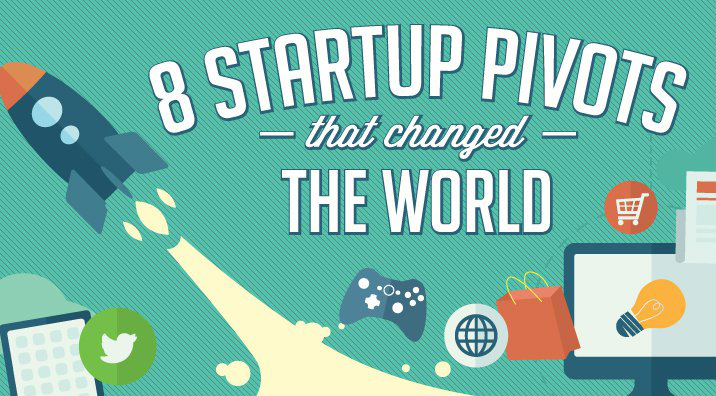Technology
These 8 Pivots by Startups Changed the World

These 8 Pivots by Startups Changed the World
How do successful companies get built? Is there a predetermined formula or ideal circumstances to get off on the right foot as an entrepreneur?
When it comes to the technology world, the truth is that the most successful companies come in all shapes and sizes. Once in a while, strategy and its execution go as planned – but more often than not, a company must change its entire basis to get its best shot at winning.
In the startup world, this is called a “pivot”. It’s a risky change of direction that could end up as a game-changing success or a resolute failure. Circumstances can change fast to prompt such a desperation move. With technological progress growing at an exponential rate, in many tech-focused businesses such pivots can even be the norm.
There are many reasons a company may shake up its strategy. Maybe the customer response isn’t what was expected, or perhaps intuition suggests that a product could be used another way with a few modifications. Sometimes a mentor or friend may have a different vision on how something can be used, and other times a competitor can apply pressure to an early-stage startup by offering a similar or better product.
I know something about pivots myself, as this website (Visual Capitalist) is the result of a few of them. We first started as a marketing consultancy, and then we gambled at the idea of using infographics to supplement the press releases of microcap public companies. Neither of those really were effective, but we still loved the idea of explaining the business and investment world with rich visuals – and eventually Visual Capitalist was born.
Similarly, many other companies that we cherish would not exist without these types of strategic pivots. Twitter, Paypal, Nintendo, and many others were born under completely different circumstances than we know them today. Nintendo built vacuum cleaners and made instant rice until they thought the video game industry could be an interesting market. Nokia, which in the late 2000s was one of the biggest mobile phone makers by market share, used to have a Finnish paper mill and manufacture rubber goods in its early stages.
Today’s infographic looks at eight of the startup pivots that have changed the world.
Original graphic by: WhoisHostingThis?
Technology
All of the Grants Given by the U.S. CHIPS Act
Intel, TSMC, and more have received billions in subsidies from the U.S. CHIPS Act in 2024.

All of the Grants Given by the U.S. CHIPS Act
This was originally posted on our Voronoi app. Download the app for free on iOS or Android and discover incredible data-driven charts from a variety of trusted sources.
This visualization shows which companies are receiving grants from the U.S. CHIPS Act, as of April 25, 2024. The CHIPS Act is a federal statute signed into law by President Joe Biden that authorizes $280 billion in new funding to boost domestic research and manufacturing of semiconductors.
The grant amounts visualized in this graphic are intended to accelerate the production of semiconductor fabrication plants (fabs) across the United States.
Data and Company Highlights
The figures we used to create this graphic were collected from a variety of public news sources. The Semiconductor Industry Association (SIA) also maintains a tracker for CHIPS Act recipients, though at the time of writing it does not have the latest details for Micron.
| Company | Federal Grant Amount | Anticipated Investment From Company |
|---|---|---|
| 🇺🇸 Intel | $8,500,000,000 | $100,000,000,000 |
| 🇹🇼 TSMC | $6,600,000,000 | $65,000,000,000 |
| 🇰🇷 Samsung | $6,400,000,000 | $45,000,000,000 |
| 🇺🇸 Micron | $6,100,000,000 | $50,000,000,000 |
| 🇺🇸 GlobalFoundries | $1,500,000,000 | $12,000,000,000 |
| 🇺🇸 Microchip | $162,000,000 | N/A |
| 🇬🇧 BAE Systems | $35,000,000 | N/A |
BAE Systems was not included in the graphic due to size limitations
Intel’s Massive Plans
Intel is receiving the largest share of the pie, with $8.5 billion in grants (plus an additional $11 billion in government loans). This grant accounts for 22% of the CHIPS Act’s total subsidies for chip production.
From Intel’s side, the company is expected to invest $100 billion to construct new fabs in Arizona and Ohio, while modernizing and/or expanding existing fabs in Oregon and New Mexico. Intel could also claim another $25 billion in credits through the U.S. Treasury Department’s Investment Tax Credit.
TSMC Expands its U.S. Presence
TSMC, the world’s largest semiconductor foundry company, is receiving a hefty $6.6 billion to construct a new chip plant with three fabs in Arizona. The Taiwanese chipmaker is expected to invest $65 billion into the project.
The plant’s first fab will be up and running in the first half of 2025, leveraging 4 nm (nanometer) technology. According to TrendForce, the other fabs will produce chips on more advanced 3 nm and 2 nm processes.
The Latest Grant Goes to Micron
Micron, the only U.S.-based manufacturer of memory chips, is set to receive $6.1 billion in grants to support its plans of investing $50 billion through 2030. This investment will be used to construct new fabs in Idaho and New York.
-

 Energy1 week ago
Energy1 week agoThe World’s Biggest Nuclear Energy Producers
-

 Money2 weeks ago
Money2 weeks agoWhich States Have the Highest Minimum Wage in America?
-

 Technology2 weeks ago
Technology2 weeks agoRanked: Semiconductor Companies by Industry Revenue Share
-

 Markets2 weeks ago
Markets2 weeks agoRanked: The World’s Top Flight Routes, by Revenue
-

 Countries2 weeks ago
Countries2 weeks agoPopulation Projections: The World’s 6 Largest Countries in 2075
-

 Markets2 weeks ago
Markets2 weeks agoThe Top 10 States by Real GDP Growth in 2023
-

 Demographics2 weeks ago
Demographics2 weeks agoThe Smallest Gender Wage Gaps in OECD Countries
-

 United States2 weeks ago
United States2 weeks agoWhere U.S. Inflation Hit the Hardest in March 2024














